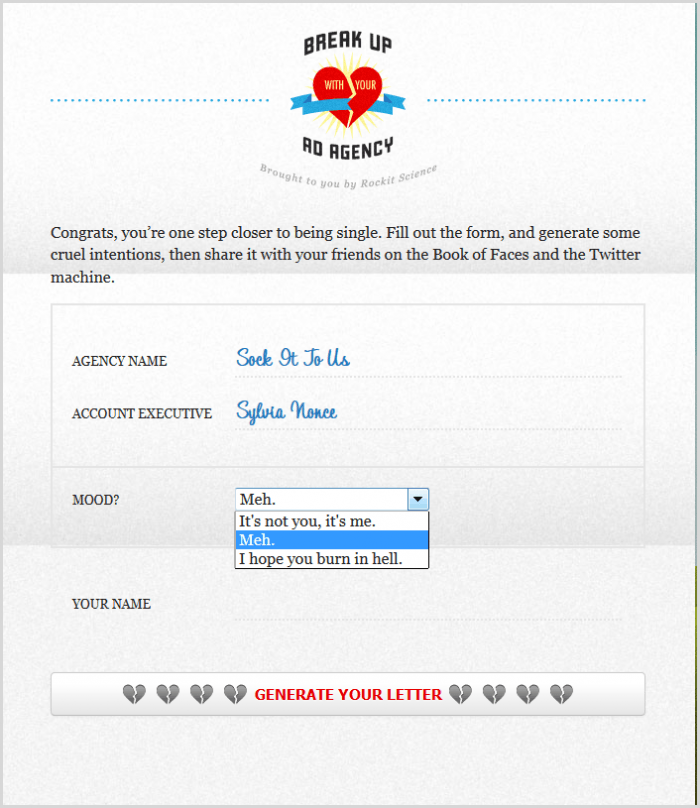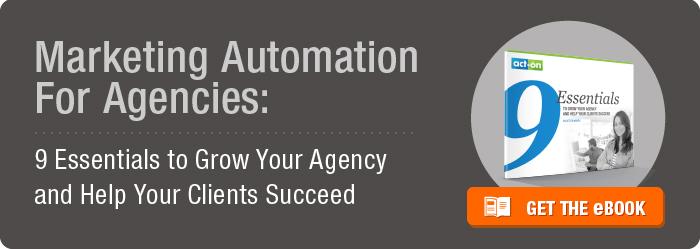 I worked at a creative agency for several years. It was a great opportunity for a writer, and I loved it because there was always something new to learn about. One day I might be writing web copy advertising snowboards; the next day I’d work on an interactive game promoting an animated movie. Working with talented, creative people was a real joy. Aside from a few clashing egos (and what creative agency doesn’t have those?), it seemed like everything was going great. Old clients were happy, new clients were knocking on the door, and business was booming. We couldn’t hire people fast enough.
I worked at a creative agency for several years. It was a great opportunity for a writer, and I loved it because there was always something new to learn about. One day I might be writing web copy advertising snowboards; the next day I’d work on an interactive game promoting an animated movie. Working with talented, creative people was a real joy. Aside from a few clashing egos (and what creative agency doesn’t have those?), it seemed like everything was going great. Old clients were happy, new clients were knocking on the door, and business was booming. We couldn’t hire people fast enough.
And then our agency lost a big client
And then suddenly, things changed. There were lots of issues, but one of the main problems was that one of our biggest clients suddenly decided to go with a different marketing agency. Instantly, the recriminations started flying. Why hadn’t we seen this coming? What could we have done to prevent it?
Changing its agency is truly hard work for a client organization – which is why there must be something really wrong in order for it to happen. It can take a long time to find a new agency, much less for that agency to learn all about the business and to become familiar with the industry as a whole. The client has to go through the often grueling process of getting the new people up to speed on their audience as well as their products and services, and everyone has to form new relationships, all over again.
In short, it’s a hassle. For a client to decide it’s really splitsville, there has to be a compelling reason. There also have to be a few subtle (and not so subtle) warning signs. So what are they, and what can you do to prevent a breakup once you spot them? Let’s take a look at the three most common breakup songs I heard during my time in the agency world.
1. “Communication breakdown.”
An agency-client relationship, like any relationship, stands or falls on the foundation of good communication. And when things are going south, there are always warning signs. Calls don’t get returned. Meetings feel tense. Vital information gets missed, and creative executions suffer the consequences.

What can you do? Communication is a two-way street, and it’s up to the agency to make twice the effort to keep the lines clear. Every agency is different, but in my personal experience, I think it’s often better to provide opportunities for the clients and the writers, designers, and developers to interact. Yes, sometimes it can be a nightmare (the one where the client demands that you make the logo bigger or add 20 more exclamation marks to the copy). But when people have the opportunity to connect on a human level, they’re more likely to listen with respect, respond with enthusiasm, and create a better product. That’s what it’s all about, after all.
Project managers, account managers, and traffic coordinators do an incredibly difficult job, and one aspect of that job is to serve as a translator and protector. Sometimes they’re protecting the client and sometimes they’re protecting the creative team. But sometimes the best thing they can do is to be a facilitator to a conversation – one that keeps the ideas flowing and the relationship going strong. I think one of the problems at the agency I worked for is that we grew too big too fast. The people in the client meetings were no longer the people doing the work, and important information got lost in translation.
2. “There’s a new kid in town.”
Every new CMO, VP, or marketing director wants to make a splash when they join a company, so it’s not surprising that when they arrive, often they bring their old marketing agency with them. It makes sense – they’re comfortable with that agency team, and confident in their ability to execute.
What can you do? Honestly, if they’ve got their mind made up, there’s not a lot you can do. That means that the key is to get to that CMO before her mind is made up. When there’s a shakeup in the marketing department at a client organization, it pays to keep your ear to the ground and find out who the new boss is going to be. As soon as you have the opportunity, make an impression on her. Find out what it would take to get her to keep your agency.
Forget the fruit basket (unless your research indicates a fruit basket is a proven winner with this person). Instead, opt for a data-driven presentation of the successes you’ve won for the organization, complete with the statistics to prove it. Demonstrate a willingness to be flexible and work with her new style. (And don’t forget to find out where the outgoing marketing executive is going to – maybe he’ll want to bring your agency along!)
3. “The times, they are a-changin’.”
The rapid evolution in technology and connectivity is having a huge impact on the client/agency relationship. Mobile, social, and big data are creating amazing opportunities (and big challenges) for marketers, and clients are counting on their agencies to navigate this shifting landscape. If the agency isn’t keeping up with the trends, the client will go elsewhere, to more knowledgeable practitioners.
What can you do? In addition to delivering brilliant creative work, you must provide cross-channel strategies that extend the reach of your messages. You need to demonstrate expertise with creating multiple types of content, and using behavioral data to deliver insightful analysis. Digital marketing makes it possible to provide in-depth campaign data, analysis, and reporting. You need to be able to create and execute amazing campaigns, and do it faster than before—and to do that, you need marketing automation.
By leveraging the power of marketing automation, agencies can differentiate themselves, increase profits, and carve market share away from larger agencies. Here’s where smaller agencies can gain the advantage as well – they’re much more agile than larger players, and that means they can adopt new technologies and techniques faster.
Client-agency breakup: A frequent occurrence
 Consider these sobering statistics from the CMO Council’s 7th annual State of Marketing survey: More than 60% of marketers expect to make an agency change in the next 12 months. Only 12% of marketers consider their agency partners to be “extremely valuable.” Yikes. I guess the thrill is gone.
Consider these sobering statistics from the CMO Council’s 7th annual State of Marketing survey: More than 60% of marketers expect to make an agency change in the next 12 months. Only 12% of marketers consider their agency partners to be “extremely valuable.” Yikes. I guess the thrill is gone.
Agencies need to stay relevant
It also means that marketing agencies have a new role: one that combines creative and content-focused services, customer-engagement management, long-term relationship management, digital-channel know-how, data-analysis capabilities, and technical expertise. All of these capabilities are made possible with marketing automation.
Learn more about how marketing automation can help agencies improve their client relationships by helping them deliver smarter strategies, more successful campaigns, and repeatable results. With the right marketing automation solution, you can improve communication with easy-to-understand dashboards that help clients understand exactly what’s going on. You can use that data to prove the value of your agency – and the importance of your expertise.
Don’t wait around to hear that breakup melody. Read this eBook to understand the nine essential strategies that can help agencies of any size take full advantage of the power and growth potential of marketing automation.
Album cover, Ray Charles’ Hit the Road Jack, Wikipedia

